
Several locations linked to African American history in Fairfax County could be eligible to be designated as historic places.
Those buildings and neighborhoods include the Louise Archer School, the Tinner Hill neighborhood and Clifton Primitive Baptist Church. Along with other candidates, they appear in a draft African American Historic Resources Survey Report, which was released on Feb. 23.
The county is looking for residents to share their thoughts on the report ahead of its final version, anticipated late this spring.
“We’re looking for feedback on the historical context and properties as written in the report,” Leanna O’Donnell, planning division director at the Fairfax County Department of Planning and Development, wrote in a statement to FFXnow.
Residents who want to weigh in on the report can do so through Friday, March 24. There will also be a virtual community meeting on the report’s findings at 6:30 p.m. on Monday (March 6).
“Any feedback will be taken into consideration as we finalize the report and help identify properties that could be nominated for inclusion in Fairfax County’s Inventory of Historic Sites, the Virginia Landmarks Register or the National Register of Historic Places,” O’Donnell wrote.
The survey report furthers the work of the African American History Inventory, a database of resources related to the county’s African American culture and history. That inventory came to be following an October 2020 motion from a commissioner on the Fairfax County History Commission.
In 2021, the county received funding through the Virginia Department of Historic Resources’ Cost Share Grant Program to support the current study.
The report includes historical information about African Americans in present-day Fairfax County, starting in the 1600s. It also features photos and descriptions of buildings and communities surveyed, as well as preliminary recommendations.
For example, the entry on Louise Archer Elementary School includes a description of the building’s location, its exterior and the surrounding area of Vienna, along with pictures of the building and some historical context.
“The evolved building is the third purpose-built school for African Americans in Vienna,” the report says. “Once Fairfax County schools began to integrate, Louise Archer School was the only formerly Black elementary school to integrate and remain open.”
The report calls the school “a strong candidate for NRHP listing.”
Of the sites not already listed, Lane’s Mill in Centreville and Luther Jackson Middle School in Merrifield were deemed eligible for the national register. Other potential candidates include McLean’s Chesterbrook Baptist Church, Clifton Primitive Baptist Church, Quander Road School in Belle Haven, and the Tinner Hill neighborhood in Falls Church.
The Gum Springs area was the only part of the county excluded from the survey. That area is “part of a more intensive survey effort focusing specifically on this prominent African American community,” according to a county press release.
The county has also moved to honor Black and African American history with new historical markers, selected late last year.
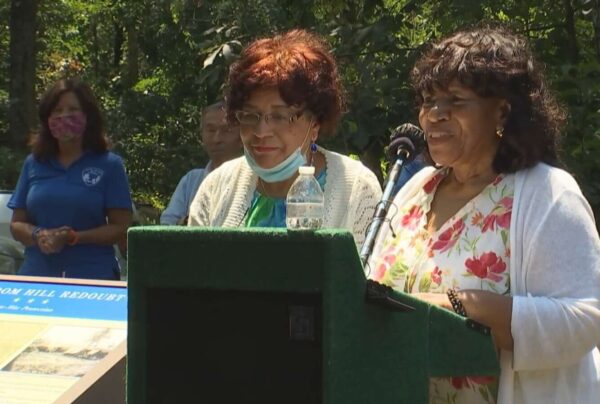
Fairfax County may get involved in the preservation of a cemetery belonging to a family with deep roots in the Vienna area, predating the formation of the U.S.
The Board of Supervisors directed staff yesterday (Tuesday) “to investigate options for addressing safety concerns” and the long-term care of the Carter Family Cemetery, a small plot near Tysons in what was once the historically Black community of Freedom Hill.
“This has been a while in coming. We’re getting to the point where there are some outcomes that may be truly viable, so [I] appreciate the board’s indulgence,” Hunter Mill District Supervisor Walter Alcorn said, noting that a final vote by the board will be needed before any action is taken.
According to the board matter, which was introduced by Alcorn and co-sponsored by Chairman Jeff McKay, descendants of the Carter family who still live in the area asked county staff for “assistance in preserving and protecting the cemetery property.”
The cemetery is located at 1737 Key West Lane in the Carter’s Green neighborhood, a subdivision of single-family houses adjacent to Raglan Road Park and the Tysons Towers senior living community.
There is one identified grave with a headstone for Millie Whales Carter that’s inscribed with the date of her death on Feb. 29, 1916 and the words “Gone but not forgotten.” The cemetery also has five or more unmarked graves, per the county’s cemetery survey.
Whales Carter was a descendant of Keziah Carter, who bought 50 acres of land in 1842 that had been inhabited by her ancestors in the indigenous Tauxenent tribe until the area’s colonization. The Carter family lived on and farmed the land for decades, later expanding into what’s now the Town of Vienna, according to the Fairfax County Park Authority.
The park authority dedicated signs at nearby Freedom Hill Park in 2021 that tell some of the Carter family’s story, but the cemetery has become neglected since the Carter’s Green subdivision was built in the 1970s, Alcorn said in the board matter.
“In recent years the Carter Family Cemetery has suffered from vandalism and dumping of landscaping waste,” the board matter says. “The immediate neighbor has also expressed safety concerns over a mature tree overhanging their property.”
The wooded lot is now “overgrown and has been used as a neighborhood dump for yard debris,” according to the Fairfax Genealogical Society.
Living members of the Carter family declined to comment for now when contacted by FFXnow, stating that they hoped to meet with Alcorn before talking to media.
The park authority says the board’s vote allows it to evaluate options for the future of the Carter Family Cemetery, but the exact role that the county will play isn’t clear yet.
“We have not yet conducted an analysis of potential solutions for this specific property in advance of the board’s directive, so we are just beginning the work of seeing what avenues might be available to help preserve this site,” an FCPA spokesperson said. “We will be providing the Board of Supervisors with proposed recommendations at a future date.”
Prior to yesterday’s vote, some supervisors suggested a countywide policy may be needed to set criteria for when and how the county should get involved in cemetery preservation efforts.
A new survey of cemetery and grave sites across the county is currently underway. The park authority’s initiative is expected to continue into 2024.
“Each one is a little different, and some might be better positioned for our engagement than others, but I think having a consistent policy across the county is going to be really important to make sure from a One Fairfax perspective that all of these cemeteries are treated fairly,” Braddock District Supervisor James Walkinshaw said.
Photo via Fairfax County Park Authority/YouTube

Nikole Hannah-Jones, the investigative journalist behind “The 1619 Project,” is coming to McLean.
Anyone hoping to snag a last-minute ticket to her talk at the McLean Community Center on Sunday (Feb. 19), however, is out of luck. Seats filled up quickly once registration opened last month, and the waitlist has exceeded 400 people, according to the Fairfax County Public Library (FCPL), which organized the free event.
Fortunately, Hannah-Jones has agreed to let the county make a recording of the event that will be shared “for a limited time” with attendees and everyone on the waitlist, FCPL Director Jessica Hudson says.
“We are honored and excited to host Ms. Hannah-Jones, a Pulitzer Prize and Peabody Award winning author, and creator of the landmark 1619 Project, during our Black History Month celebration,” Hudson said in a statement. “Authors are chosen for a variety of reasons including educational value, because they inspire a high level of interest among our diverse community members, and for their ability to offer unique insight into important cultural and social issues.”
Since launching in The New York Times Magazine on Aug. 14, 2019, The 1619 Project has ignited vigorous debate among academics and the general public alike over its argument that racism and slavery are foundational — not incidental — to American history.
The initiative won awards for Hannah-Jones, including a 2020 Pulitzer Prize, and has expanded with a teaching guide, podcast, the nonfiction book “The 1619 Project: A New Origin Story,” the kids’ book “Born on the Water,” and most recently, a documentary series on Hulu.
The project’s longevity surprised even its author — as has the intense backlash, which has manifested in everything from historians disputing specific claims to politicians banning it from classrooms.
Far from being wary, Hannah-Jones wants to visit states like Virginia, where pushback to her work and the once-niche academic concept of critical race theory has evolved into broader fights over how history is taught in schools and access to books. She spoke in Arlington last year for “Banned Books Week.”
“It’s really important for me to go into places that are having these battles,” she told FFXnow. “Really, I see part of it as standing up for teachers and librarians and students’ right to learn, but of course, in a place like Virginia or a place like Fairfax County, or a place like Arlington, or really anywhere, we are daily seeing how the legacy of slavery is shaping lives, and people don’t often recognize that.” Read More

Before he helped oversee the Washington Nationals’ rise from cellar dwellers to World Series champions, Ted Lerner was busy building Tysons.
The real estate developer who transformed rural farmland into Fairfax County’s urban center died Sunday (Feb. 12) at the age of 91 in his Chevy Chase, Maryland, home. The cause was complications from pneumonia, as first reported by the Washington Post.
As founder and principal of Lerner Enterprises, Lerner laid the groundwork for Tysons by establishing Tysons Corner Center — now one of the biggest and busiest malls in the D.C. area — and the nearby Tysons II development. This work made him a visionary in the eyes of those now charged with shaping the area’s future.
“Ted Lerner was a visionary who laid a foundation for a mixed use Tysons Center which is now continuing to evolve into a dynamic urban community,” Tysons Community Alliance Chair Josh White said to FFXnow. “His contributions will continue on well into the future.”
In a memorial video from Lerner Enterprises, Lerner said his work in both real estate and baseball focused on “striving for excellence and building for future generations.”
“That way, it’s not about the properties at all. It’s about community. It’s about the future,” he said.
A native of D.C. and Army veteran, Theodore Lerner entered the real estate industry in 1951 with a $250 loan from his wife, painter and sculptor Annette Morris, according to a bio provided by the Nationals.
After initially getting a foothold in housing as a pioneer of concepts like model houses and centralized sales, he turned to the retail market with investments in Maryland’s Wheaton Plaza, which opened in 1960, and the land at the intersection of routes 7 and 123 then known as Tysons Corner.
When Lerner and fellow developer Gerald Halpin started building in Tysons, the area had little in the way of amenities beyond a corner store and a beer joint amid dairy farms and fruit orchards, according to the Post. That changed with the arrival of the Capital Beltway in 1961 and Dulles International Airport in 1962.
In a heated battle for control, the developer team of Lerner, Homer Gudelsky and H. Max Ammerman beat Baltimore banker James Rouse to get the Fairfax County Board of Supervisors’ approval for its $20 million plan to build a shopping center on 85 acres on the northeast side of the crossroads.
Tysons Corner Center opened in 1968 to quick success with an initial focus on local businesses, the Post reported in an extensive 1988 profile.
“When Tysons was still an apple orchard, he understood the potential for population growth and the demand for retail that would follow,” Fairfax County Economic Development Authority president and CEO Victor Hoskins said. “He predicted the emergence and value of enclosed malls which were a new concept at the time and helped transform Tysons into a predominant retail cluster in the Mid-Atlantic region.” Read More
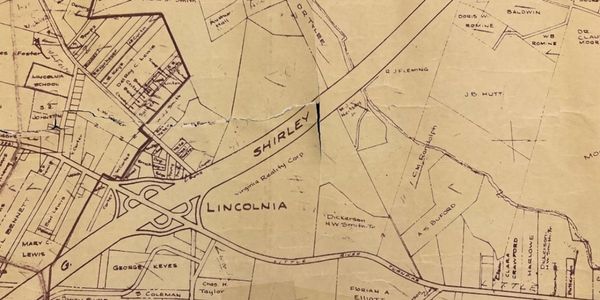
A newly awarded grant will help the Fairfax County Circuit Court preserve some historical records dating back to the 18th century, including one map that laid out the battlefield in a small legal war between the county and Alexandria City.
The 4-foot-long, 3-foot-tall Alexandria Annexation Map was impossible to fully photograph in its entirety because of its rough shape, but restoration work should help clear it up, said Heather Bollinger, the historic records manager at the Fairfax County Historic Records Center.
Billinger said the unique map shows many of the Black communities throughout the West End, some of which date back to the aftermath of the Civil War. Some were scattered by racist city policies, like the Ford Ward community, which was converted into a park in the 1960s with little regard for where bodies were buried on the site.
“It was a snapshot of the 1950s,” Billinger said. “You can see where there were smaller communities setting up new neighborhoods, a lot of African American communities.”
Billinger said the maps are a testament to the communities that are now lost to history.
“The map itself is fascinating,” Billinger said. “What’s most interesting about it is: it’s a snapshot in time. What we see on this map is several communities owned by African Americans, like Dowden Terrace.”
Billinger said the maps of that area look very different today.
“Now, that area of Fairfax and Alexandria is heavily developed,” Billinger said. “This is what it looked like before that westward expansion. We don’t have many maps that show that westward expansion. The post-World War II major population explosion was just starting to happen…If you were to do an overlay of the map now, it doesn’t look anything like it did.”
The map came to the forefront of a legal fight in 1951 when Alexandria filed a lawsuit to annex the West End from Fairfax County, citing a need for extra territory and being in a better position to offer utilities to West End residents.
Billinger said similar lawsuits were the common method of sorting out issues of annexation and ceding territory. There was a similar case when the City of Fairfax sought autonomy from Fairfax County. Most of it comes down to who is in a better position to provide utility coverage, Billinger said.
The Fairfax County Circuit Court was awarded a grant for $22,419.50 that will also be used to preserve records related to deeds and land taxes.
In addition to being physically housed at the Historic Fairfax Courthouse, the records will be made available digitally through the circuit court’s online Court Public Access Network, a subscriber-based database that has records dating back to 1742.
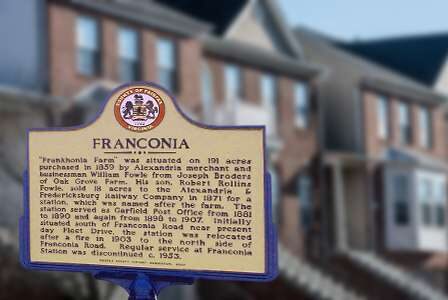
General Robert E. Lee has suffered another defeat in Virginia — the Fairfax County Board of Supervisors has voted to rename the Lee District to the Franconia District.
The board unanimously approved changing the county code to reflect the new name on Tuesday (Dec. 6), formalizing a change that it had already supported in June.
The name change is the latest in a series of efforts to disentangle localities from names honoring Confederate leaders, though Fairfax County’s release noted that there is no conclusive historical evidence that the district was named for Robert E. Lee.
Still, the release said the general perception is that the name honors Lee. Name changes for that district and Sully District were recommended in March by the county’s Redistricting Advisory Committee.
While other officers like John Mosby have also been brought up for discussion, Lee has been an easy and iconic target for renaming. In 2019, Arlington renamed its Washington-Lee High School to Washington-Liberty, and Fairfax County Public Schools renamed Robert E. Lee High School for Rep. John Lewis in 2020.
Supervisor Rodney Lusk helped launch the renaming initiative last March and said it’s been an issue on his mind for years:
Back when I was a candidate, I heard from many in the community about their desire to have conversations about [the name]. For me, as an African American and a proud resident of this district for the past 22 years; whose lived my life, raised my two African American daughters under the signage of the Robert E. Lee Recreation Center, under the signage of Robert E. Lee High School, it’s been a conversation I’ve carried in my heart for many years, and I know that’s true for many others in our community… As we turn the page and continue to write the history of our community; we’re not erasing history, we’re making it.
Staff said much of the groundwork required for the name change has already been laid out. The last changes will be updates to the county’s GIS mapping and election precincts, which will all be completed this spring.
“Residents deserve a community that better reflects them,” Board of Supervisors Chairman Jeff McKay said. “We can’t go back and change history, but we absolutely have a right to decide what it is in history we want to celebrate and what it is in history we want to learn from and do better.”
The county release said the renaming will also include:
- Lee District Rec Center, which is now known as the Franconia Rec Center
- Lee District Park is now called Franconia Park
- Lee High Park is now Lewis High Park
- Lee Residential Permit Parking District is now the Lewis Parking District
- Lee Community Parking District is now renamed the Franconia Parking District
The day after the Board of Supervisors vote, the Fairfax County Park Authority announced that its board had unanimously approved renaming three of its facilities:
- Lee High Park to Lewis High Park
- Lee District Rec Center to Franconia Rec Center
- Lee District Park to Franconia Park
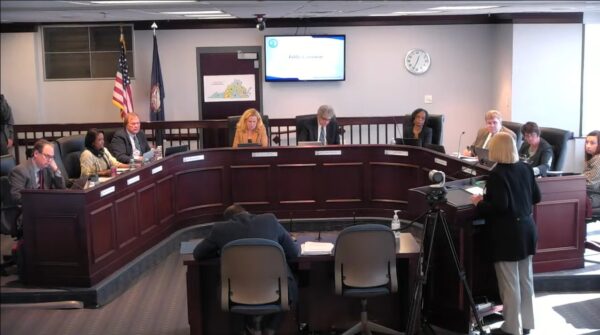
Fairfax County’s teacher unions expressed relief after new state-proposed history standards were rejected by a governor-appointed board late last week.
On Thursday evening (Nov. 17), Virginia’s Board of Education voted unanimously to again delay approving new history standards drafted by the Virginia Department of Education (VDOE).
The proposed standards had numerous admitted mistakes, errors and typos, and was radically changed from a 400-page working draft first publicly released over the summer.
The new document was also significantly shorter. A longer “framework” document which will include information on how to teach the material will be released next summer, per the Washington Post.
“We are pleased to see that the Board of Education has heard the voices of teachers, students, parents, and community activists,” Fairfax County Federation of Teachers (FCFT) President David Walrod said. “The draft of standards presented [Thursday] was hastily assembled, with multiple new versions being released in a matter of days.”
Among the most discussed changes in the draft standards were omissions of both Martin Luther King Jr. Day and Juneteenth as holidays. They also described Virginia’s indigenous peoples as America’s “first immigrants,”
The draft also eliminated racism in America as a central theme to be taught in many grades, while removing instances of teaching students about culture and government outside Europe and the U.S.
The board’s rejection came after a four-hour public hearing where a number of speakers, including Walrod, called the new standards a “whitewashing” of history.
Union President @dpwalrod tells Virginia Board of Education Members NO to the whitewashing of our social studies standards! pic.twitter.com/aemiGGVnzY
— Fairfax County Federation of Teachers (@FCFTcares) November 18, 2022
The VDOE first released this draft less than a week before the board was scheduled to vote on it, leading members to complain about the short timeframe for reviewing such large changes.
The approval had already been postponed from August after a previous draft was similarly riddled with mistakes and errors. That draft was also about 400 pages long, compared to the 57-page document this time around. Read More
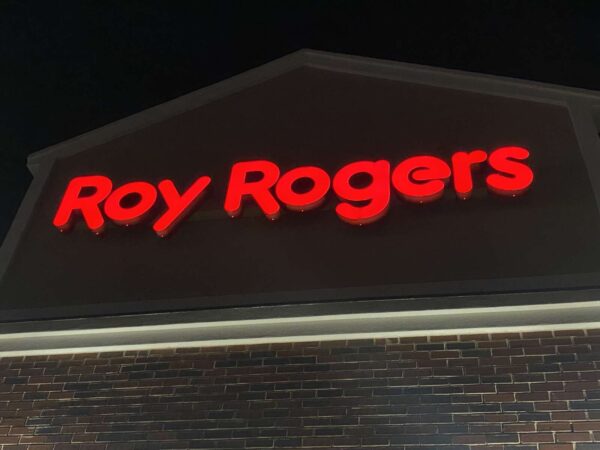
(Updated at 4:20 p.m.) On an April day in 1968, Roy “King of the Cowboys” Rogers and his wife — “Queen of the West” Dale Evans — appeared in front of thousands along Leesburg Pike in Bailey’s Crossroads to open America’s first Roy Rogers.
“Inside the shoppe, Roy and Dale served up hot Roast Beef sandwiches to the first several customers,” promotional materials said at the time. “Over 5,000 autographed pictures of Roy and Dale were passed out to customers.”
Yes, despite the Old West motif and being named after a movie star cowboy, the fast food chain known for its roast beef and fried chicken began in Fairfax County, opening its first restaurant at 5603 Leesburg Pike.
Today, it’s now a McDonald’s set to undergo a revamp.
The story behind how Roy Rogers came to be born in Fairfax County starts with J. Willard Marriott, founder of the once-local but now-international hotel chain.
“Mr. Marriott wanted to get into the fast food business,” Jim Plamondon, co-president of Roy Rogers restaurants, told FFXnow. “Just like what Ray Kroc was doing with McDonald’s.”
Marriott began his career running a D.C. root beer shop before transitioning to a coffee shop-style eatery called Hot Shoppe. He opened his first hotel in Arlington in 1957.
But fast food was hot in the 1960s, and Marriott, an experienced restaurant owner, wanted a bite of that market too. So, when a new roast beef franchise called “RoBee’s House of Beef” opened in the Midwest, Marriott decided to acquire it, Plamondon explained.
Plamondon knows this history intimately. His father, Peter Plamondon Sr., was an executive in charge of Marriott’s restaurant division at the time, and he helped the hotel company launch its fast food business.
However, legal reasons prevented the company from acquiring RoBee’s trademark, so they needed a new name.
“One of the people on [Marriott’s] board of directors…said ‘Well, I know the agent for Roy Rogers, the cowboy,'” Plamondon said. “[Rogers] was a rock star back then. I mean, he was huge. He was as big as any movie star you would name today.”
Rogers was also very amendable to licensing his image and name to merchandise and businesses. At one point in the mid-20th century, more than 400 products had Roy Rogers’s name on them — second only to Walt Disney, per Rogers’s official website
Marriott and Roy Rogers struck an agreement, and the new fast food restaurant took on the Hollywood cowboy’s name. Read More
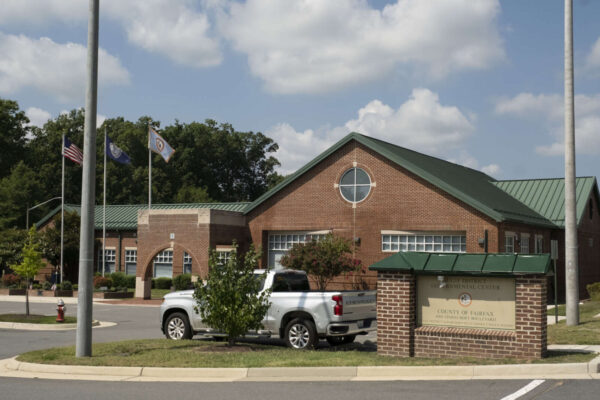
Fairfax County has opted not to move forward with a potential Sully District renaming.
Sully District Supervisor Kathy Smith announced at yesterday’s board meeting that she believes “the best step forward at this time is to retain” the name of the magisterial district, which encompasses the southwestern corner of Fairfax County.
Based on input from virtual town halls, emails, and community conversations, she proposed instead finding new ways to educate residents and visitors about the area’s history, particularly at the plantation in Chantilly that gave the district its name and is now the Sully Historic Site.
“In working on a path forward, I am actively talking with the NAACP, the county’s equity officer and the Fairfax County Park Authority executive director about ways we can have a more honest conversation about the history of our country, county and the Sully District,” Smith said in her board matter.
Supported without further discussion by the full Board of Supervisors, the decision concludes a months-long effort to gather public feedback after the county’s 2021 Redistricting Advisory Committee (RAC) recommended name changes for Sully and the former Lee District earlier this year.
After completing its primary task of redrawing the county’s electoral district maps, the committee was charged in January with reviewing whether to rename any districts based on possible historical ties to the Confederacy, slavery or racism.
According to a report finalized in March, Sully District was named after the plantation built by Richard Bland Lee, the first person to represent Northern Virginia in Congress. It said four generations of humans had been enslaved and trafficked at the property, including over 100 people during Lee’s tenure as owner.
When Lee inherited the land from his father in 1787, he received 29 enslaved people, according to the park authority’s history of the site, which features Lee’s 225-year-old house as well as 120 acres of park, gardens, a smokehouse and other structures.
While the website acknowledges the presence of slavery, it refers to the property as Lee’s “country home.” Smith’s board matter suggested that the county be more active and creative in providing information and programming about that aspect of the site’s history.
Smith said people weighed in with a variety of perspectives on whether to rename Sully District, including at town halls held on June 2 and Sept. 1, but the “most important thing I heard in these conversations was the need to heal our community.”
“The best way to do this is to work on ways to tell the true story of our sometimes complicated and misunderstood history and that of the Sully District specifically,” she said. “One way to do this is to educate the public about how land was developed, who benefitted and who was marginalized in the process.”
In addition to reevaluating what stories are told at the Sully Historic Site, the county could highlight historically Black neighborhoods affected by its westward expansion, similar to efforts to preserve Gum Springs in the Mount Vernon area. Read More
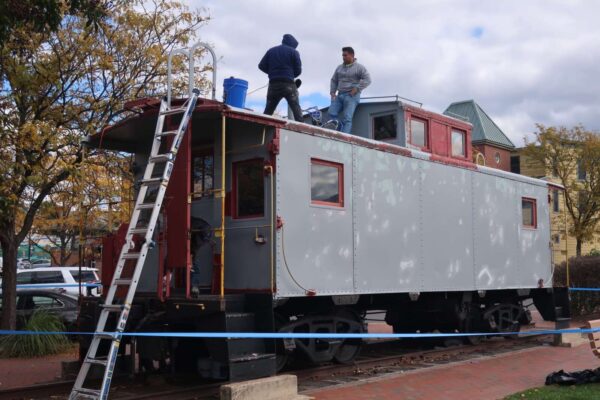
The iconic caboose in Downtown Herndon next to Herndon’s Railroad Depot and the Washington & Old Dominion Trail is getting a facelift.
Earlier this month, crews began working on repairing the exterior structure of the caboose. The project is expected to wrap up some time next month, according to the Town of Herndon’s Department of Public Works.
According to town staff, the caboose developed surface rust and paint began chipping off of the exterior, prompting the need for the project.
“The project involves the removal of the rust, repainting of the exterior surfaces including the undercarriage, and restoration painting of the W&OD seal and associated lettering on the caboose,” the town wrote in a statement to FFXnow.
The caboose was brought to the Town of Herndon in 1989 after the Herndon Historical Society expressed interested in securing a caboose for the Herndon depot.
The all-steel caboose, which weights 45,300 pounds and is roughly 37 feet long is base don a design used on U.S. railroads after World War II.
The latest work on the caboose is being completed by The Matthews Group, Inc. under the supervision of the town’s Department of Public Works.
Photo via NOVA Parks/Twitter

